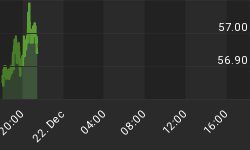A persistent presumption here is the limit to U.S. government bond issuance that (important qualification coming) can be traded at government-manufactured rates. "March 2014 - One Month Closer," issued the reminder: "Bond yields, across the spectrum, have fallen from 4.8% to 2%. In an open market, bond investors handicap their purchases according to a calculated risk. This is a rigged market, though. The rising quantity has produced worse quality, but central planners disguise that fact." The conclusion to "The Economist's Sell Signal," (November 30, 2013) proposed a shorthand approach to investing as we approach the inevitable moment when non-government market participants say "enough": "The Economist's article was unbalanced, sloppy, and abandoned by the starting team: much like the world's markets. A suggestion for current asset allocation: where would you want your money today if you knew interest rates will rise by 4.0% tomorrow?"
In spectacular fashion, markets did say "enough" in Japan last week. Yet, interest rates did not move. Recall "important qualification coming" in the paragraph above. On Monday, April 14, 2014, and, into Tuesday, April 15, 2014, there was not a single bid for the Japanese 10-year bond. John Rubino, at DollarCollapse.com, in "Amazing Story from Japan," quotes Reuters: "The Bank of Japan's massive purchases of government debt hit a milestone this week, sucking liquidity out of the market to such an extent that the benchmark 10-year bond went untraded for more than a day...." Rates did not move because, for every 10-year Japanese government bond seeking a purchaser, the Bank of Japan created electronic yen (it "printed money") and paid exactly the price necessary to hold the 10-year rate at 0.6%. The looming question is how long the Bank of Japan (or, in an entirely imaginable similar situation, the Federal Reserve) will continue printing (electronically crediting yen or dollars to the seller) when the market decides: "I'm outta' here!"
The Japanese experiment, described and condemned in "We Are All Lab Rats Now," is an exaggerated form of the Federal Reserve's extermination program. Keep in mind how Fed officials brag of their successful "liquidity" apparatus in light of the overdrive, Bank of Japan, balance-sheet expansion. Since March 2013, the BoJ balance sheet has blossomed from ¥125 trillion ($1.23 trillion) to ¥200 trillion ($1.96 trillion) of Japanese government bonds. Bank of Japan Governor Haruhiko Kuroda, more recently labeled Hari Kari Kuroda (that is: here and now) received carte blanche authority to inflate Japanese prices. Inflation is "gaining traction" as economists say, but the results have been exactly and completely in contradiction to Kuroda's promises.
A year into the Kuroda regime, the Bank of Japan has strangled markets. Quoting Rubino: "The fall in market liquidity looks set to intensify as the BoJ has vowed to continue its aggressive buying for at least another year, with market players expecting it to expand its easing some time later this year.... The increasing dominance of the BoJ in the market [has] resulted in a shortage of tradable bonds in the market, reducing trading flows between market players. Brokers are reluctant to go short, fearing that they cannot buy back when they want. On the other hand, few investors are willing to chase prices higher, when the 10-year bonds yield about 0.6%."
Kuroda must think this is a dream come true - the boost to inflation-traction he is supplying by printing enough money to prevent yields on $10 trillion worth of Japanese government bonds from rising. He now holds 20% of Japanese government bonds.
Richard Fisher, President of the Dallas Fed, delivered a presentation in his district on April 16, 2014. Slide number six is appropriate to the current discussion. There is no transcript to this talk on the Dallas Fed website. The title may be ironic or sarcastic, evidence suggested below:
"The U.S. Credit Markets Are Awash in Liquidity"
* As of March 2014, the Fed's par holdings of fixed-rate MBS [mortgage-backed securities - FJS] exceeded 30 percent of the outstanding stock of those securities.
*The Fed owns just shy of 24 percent of the stock of Treasury coupon securities. [The BoJ only holds 20% - FJS]
* Having purchased Treasuries further out on the yield curve, and done so in size, the Fed has driven nominal interest rates across the credit spectrum to lows not seen in over a half century.
* This has allowed U.S. businesses to restructure their balance sheets and creatively manage their earnings.
Source: Federal Reserve Bank of Dallas
On the final point, Fisher has criticized Federal Reserve interest-rate suppression for suctioning capital towards wasteful and misleading operations. Misleading have been the operating-earnings charades (one-time write-offs, every quarter) and substitution of debt for equity to boost stock-option payouts. The April 22, 2013, King Report states "since 2009, total revenue growth [of S&P 500 companies] has grown by just 31% while profits have skyrocketed by 253%." Thus, evidence (as promised) that Richard Fisher may not have discussed Fed interference with equanimity.
The Dallas Fed president is unique, among FOMC members. He actually managed money, including distressed debt, so knows cycles cannot be avoided. Suppression of cycles distorts markets. Market suppression inevitably leads to panic. "Going for Broke" (January 30, 2013) laid out how the Greenspan Fed advertised its liquidity prowess, which inevitably turned into its opposite: "When 'ample liquidity' is the rationalization for participating in detached markets, you can depend upon it: the liquidity will not be there when it is needed most. Following the Long-Term Capital Management hullabaloo in 1998, Marty Fridson, then at Merrill Lynch, now proprietor of FridsonVision LLC, etched this identity in granite: "[LTCM] forgot that in times of panic, all correlations go to one.'"
Federal Reserve Chairman Janet Yellen can really test her "Communications in Monetary Policy" thesis when all government and mortgage bondholders seek dollar redemption as correlations are moving towards one.
Frederick Sheehan writes a blog at www.aucontrarian.com
















